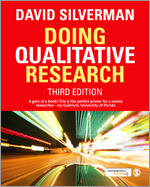I was reading through Chapter 4 of Silverman’s (2010) Doing Qualitative Research. This chapter looks at the methodological approaches that different students take. This is, of course, an important part of having a framework from which to hang your analysis. There are so many choices. He starts off with some descriptions of students describing their work as discourse analysis, narrative, analysis, and hermeneutics. At first I thought this was related to something I’d looked up earlier in the month, heutagogy, but it’s just that they both start with “he”. Wikipedia defines hermeneutics like this:
Hermeneutics (English pronunciation: /hɜrməˈnjuːtɨks/) is the study of interpretation theory, and can be either the art of interpretation, or the theory and practice of interpretation. Traditional hermeneutics — which includes Biblical hermeneutics — refers to the study of the interpretation of written texts, especially texts in the areas of literature, religion and law. Contemporary, or modern, hermeneutics encompasses not only issues involving the written text, but everything in the interpretative process. This includes verbal and nonverbal forms of communication as well as prior aspects that affect communication, such as presuppositions, preunderstandings, the meaning and philosophy of language, and semiotics.[1] Philosophical hermeneutics refers primarily to Hans-Georg Gadamer’s theory of knowledge as developed in Truth and Method, and sometimes to Paul Ricoeur.[2] Hermeneutic consistency refers to analysis of texts for coherent explanation. A hermeneutic (singular) refers to one particular method or strand of interpretation.
Wikipedia (2010)
It’s apparently related to computational semiotics or used in computational semiotics. That reminds me of James Paul Gee again because he talks about the semiotics of things in his What Video Games Have To Teach Us about Learning and Literacy (2007). Is it another sign that I need to be looking at Gee’s book on discourse analysis (Gee 2011)?
References
Gee, J.P. (2007) What Video Games Have To Teach Us About Learning and Literacy, 2nd edition, New York, NY, United States, Palgrave Macmillan.
Gee, J.P. (2011) An Introduction to Discourse Analysis Theory and Method, 3rd edition, Abingdon, United Kingdom, Routledge.
Silverman, D. (2010) Doing Qualitative Research: A Practical Handbook, 3rd edition, London, United Kingdom, Sage Publications Ltd.
Wikipedia. (2010) Hermeneutics, [online] web page, Wikipedia. Available from: http://en.wikipedia.org/wiki/Hermeneutics (Accessed September 21, 2010).











